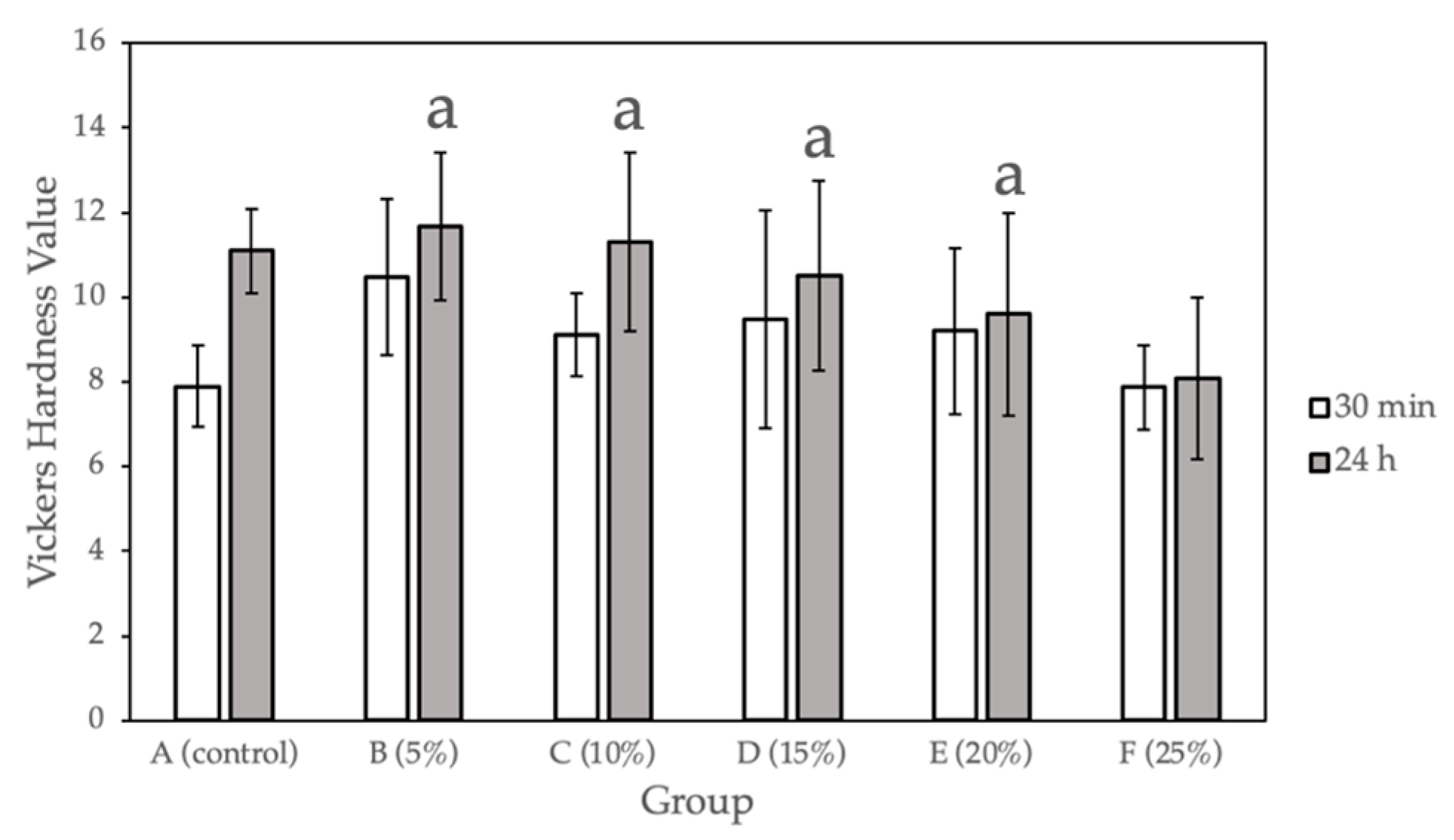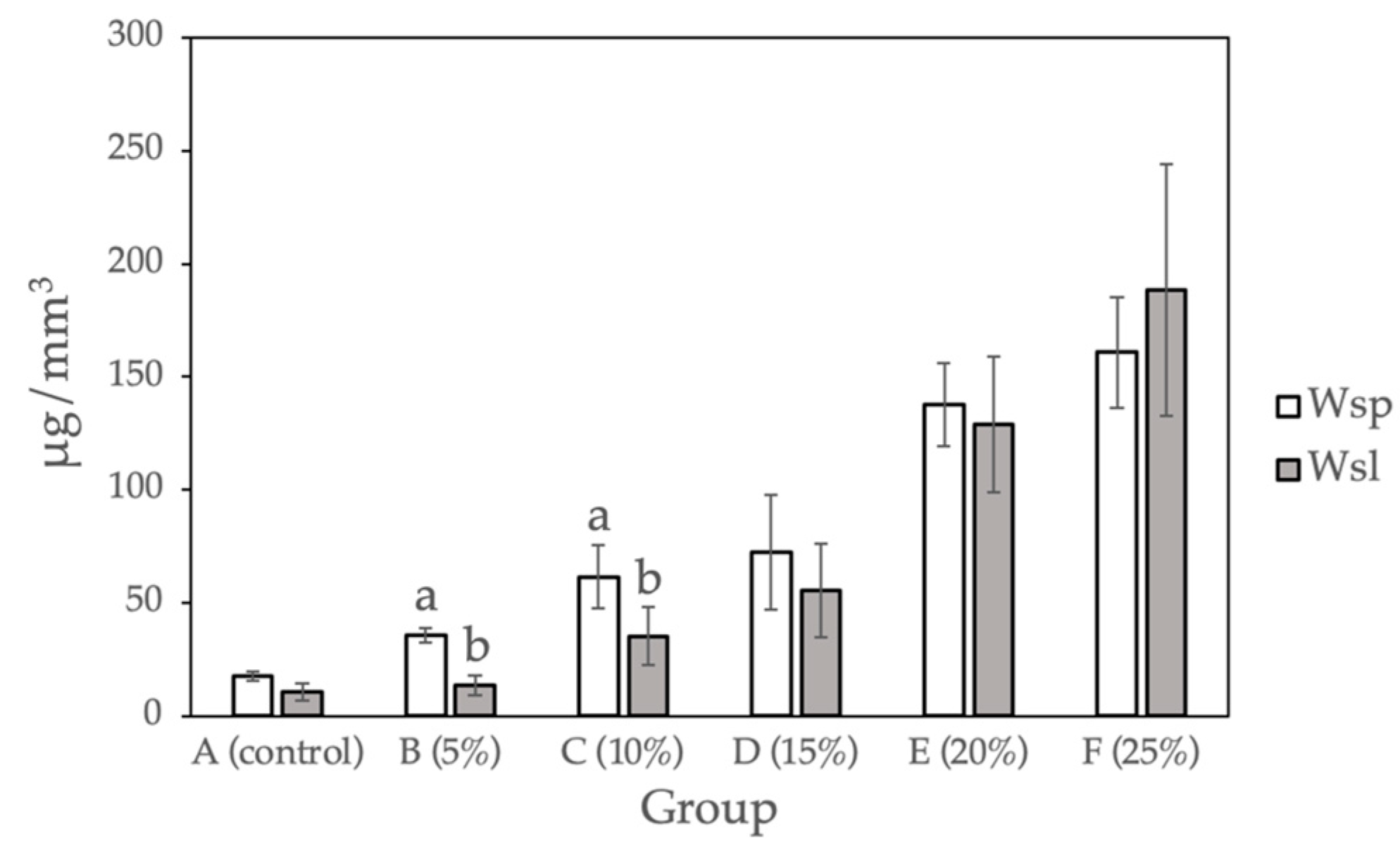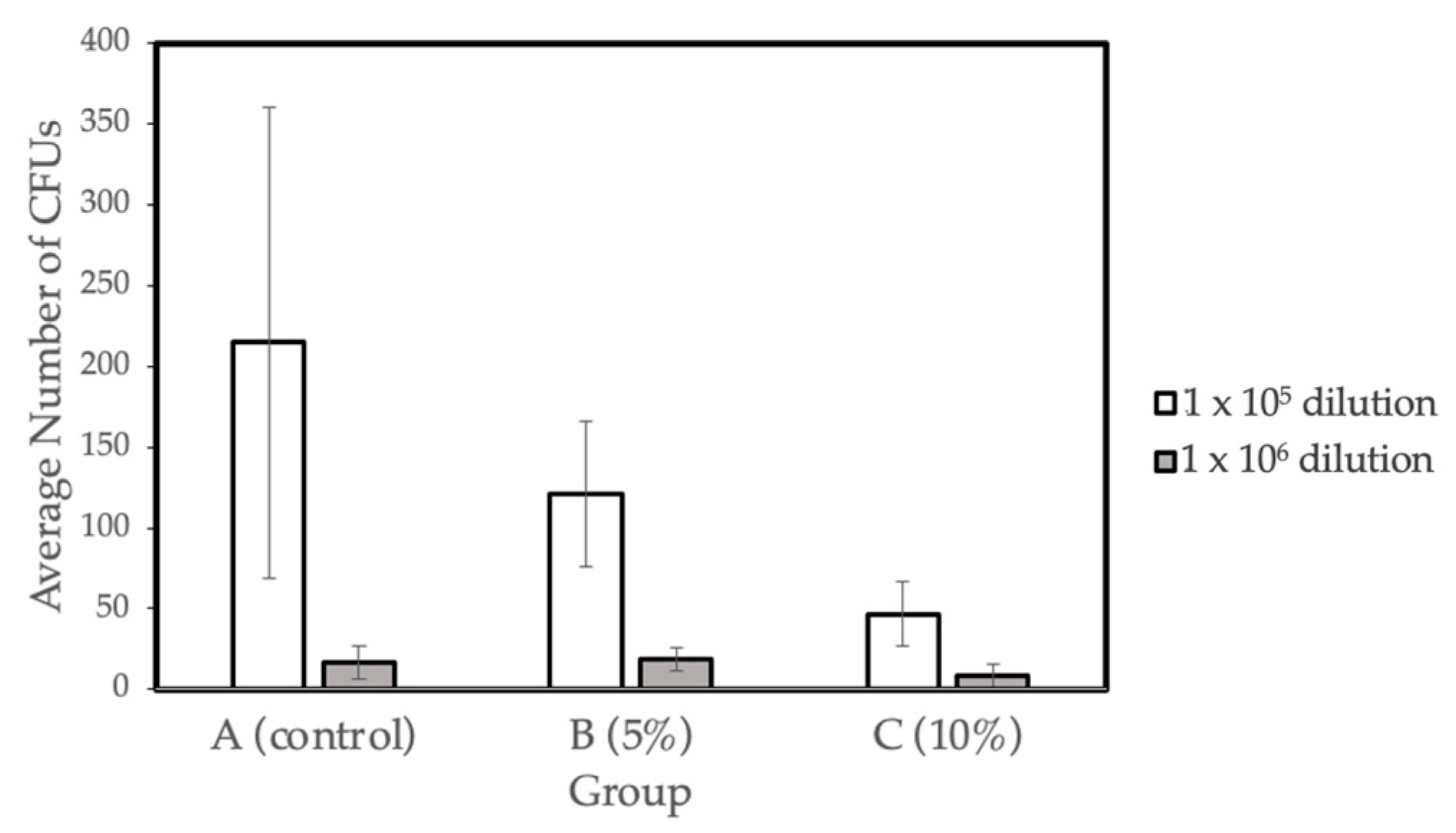Antibacterial and Physical Properties of PVM/MA Copolymer- Incorporated Polymethyl Methacrylate as a Novel Antimicrobial Acrylic Resin Material
Abstract
1. Introduction
2. Results
2.1. Surface Hardness (Vickers) Test
2.2. Flexural Test
2.3. Water Sorption and Water Solubility Tests
2.4. Microbiology Test
3. Discussion
3.1. Vickers Hardness
3.2. Flexural Strength
3.3. Water Sorption and Water Solubility
3.4. Antibacterial Properties
4. Materials and Methods
4.1. Sample Preparation with Various Ratios of PMMA and Gantrez
4.2. Surface Hardness (Vickers) Test
4.3. Water Sorption and Water Solubility Tests
4.4. Flexural Test
4.5. Microbiology Test
5. Conclusions
Author Contributions
Funding
Institutional Review Board Statement
Informed Consent Statement
Data Availability Statement
Conflicts of Interest
Sample Availability
References
- Cunningham, S.J.; Jones, S.P.; Hodges, S.J.; Horrocks, E.N.; Hunt, N.P.; Moseley, H.C.; Noar, J.H. Advances in orthodontics. Prim. Dent. Care 2002, 9, 5–8. [Google Scholar] [CrossRef] [PubMed]
- Matsuo, H.; Suenaga, H.; Takahashi, M.; Suzuki, O.; Sasaki, K.; Takahashi, N. Deterioration of polymethyl methacrylate dentures in the oral cavity. Dent. Mater. J. 2015, 34, 234–239. [Google Scholar] [CrossRef] [PubMed]
- Frazer, R.Q.; Byron, R.T.; Osborne, P.B.; West, K.P. PMMA: An essential material in medicine and dentistry. J. Long Term Eff. Med. Implant. 2005, 15, 629–639. [Google Scholar] [CrossRef]
- Zafar, M.S. Prosthodontic Applications of Polymethyl Methacrylate (PMMA): An Update. Polymers 2020, 12, 2299. [Google Scholar] [CrossRef]
- Deb, S. Polymers in dentistry. Proc. Inst. Mech. Eng. H 1998, 212, 453–464. [Google Scholar] [CrossRef] [PubMed]
- Retamoso, L.B.; de Morais Alves da Cunha, T.; Pithon, M.M.; dos Santos, R.L.; Martins, F.O.; Romanos, M.T.; Tanaka, O.M. In vitro cytotoxicity of self-curing acrylic resins of different colors. Dent. Press J. Orthod. 2014, 19, 66–70. [Google Scholar] [CrossRef] [PubMed][Green Version]
- Ghorbanzadeh, R.; Pourakbari, B.; Bahador, A. Effects of baseplates of orthodontic appliances with in situ generated silver nanoparticles on cariogenic bacteria: A randomized, double-blind cross-over clinical trial. J. Contemp. Dent. Pr. 2015, 16, 291–298. [Google Scholar] [CrossRef] [PubMed]
- Topaloglu-Ak, A.; Ertugrul, F.; Eden, E.; Ates, M.; Bulut, H. Effect of orthodontic appliances on oral microbiota—Six months follow-up. J. Clin. Pediatr. Dent. 2011, 35, 433–436. [Google Scholar] [CrossRef]
- Naranjo, A.A.; Triviño, M.L.; Jaramillo, A.; Betancourth, M.; Botero, J.E. Changes in the subgingival microbiota and periodontal parameters before and 3 months after bracket placement. Am. J. Orthod. Dentofac. Orthop. 2006, 130, 275.e17–275.e22. [Google Scholar] [CrossRef]
- Pesci-Bardon, C.; Fosse, T.; Serre, D.; Madinier, I. In vitro antiseptic properties of an ammonium compound combined with denture base acrylic resin. Gerodontology 2006, 23, 111–116. [Google Scholar] [CrossRef]
- Bettencourt, A.F.; Neves, C.B.; de Almeida, M.S.; Pinheiro, L.M.; Oliveira, S.A.; Lopes, L.P.; Castro, M.F. Biodegradation of acrylic based resins: A review. Dent Mater 2010, 26, e171–e180. [Google Scholar] [CrossRef]
- Lessa, F.C.R.; Enoki, C.; Ito, I.Y.; Faria, G.; Matsumoto, M.A.N.; Nelson-Filho, P. In vivo evaluation of the bacterial contamination and disinfection of acrylic baseplates of removable orthodontic appliances. Am. J. Orthod. Dentofac. Orthop. 2007, 131, 705.e11–705.e17. [Google Scholar] [CrossRef] [PubMed]
- Vento-Zahra, E.; De Wever, B.; Decelis, S.; Mallia, K.; Camilleri, S. Randomized, double-blind, placebo-controlled trial to test the efficacy of nitradine tablets in maxillary removable orthodontic appliance patients. Quintessence 2011, 42, 37. [Google Scholar]
- Ko-Adams, C.; Cioffi, I.; Dufour, D.; Nainar, S.M.H.; Lévesque, C.M.; Gong, S.G. Short-term effects of fixed orthodontic appliance on concentrations of mutans streptococci and persister cells in adolescents. Am. J. Orthod. Dentofacial. Orthop. 2020, 157, 385–391. [Google Scholar] [CrossRef] [PubMed]
- Arab, S.; Bahador, A.; Sodagar, A.; Pourhajibagher, M.; Akhavan, A.; Hafith, A.N.; Pornamazeh, T. Antimicrobial Properties of Acrylic Resin Incorporated with Propolis Nanoparticles. Front. Dent. 2021, 18, 29. [Google Scholar] [CrossRef]
- Giti, R.; Zomorodian, K.; Firouzmandi, M.; Zareshahrabadi, Z.; Rahmannasab, S. Antimicrobial Activity of Thermocycled Polymethyl Methacrylate Resin Reinforced with Titanium Dioxide and Copper Oxide Nanoparticles. Int. J. Dent. 2021, 2021, 6690806. [Google Scholar] [CrossRef]
- Carvalho, L.D.; Peres, B.U.; Maezono, H.; Shen, Y.; Haapasalo, M.; Jackson, J.; Carvalho, R.M.; Manso, A.P. Doxycycline release and antibacterial activity from PMMA/PEO electrospun fiber mats. J. Appl. Oral. Sci. 2019, 27, e20180663. [Google Scholar] [CrossRef]
- Gong, S.Q.; Epasinghe, J.; Rueggeberg, F.A.; Niu, L.N.; Mettenberg, D.; Yiu, C.K.; Blizzard, J.D.; Wu, C.D.; Mao, J.; Drisko, C.L.; et al. An ORMOSIL-containing orthodontic acrylic resin with concomitant improvements in antimicrobial and fracture toughness properties. PLoS ONE 2012, 7, e42355. [Google Scholar] [CrossRef]
- McConnell, M.D.; Liu, Y.; Nowak, A.P.; Pilch, S.; Masters, J.G.; Composto, R.J. Bacterial plaque retention on oral hard materials: Effect of surface roughness, surface composition, and physisorbed polycarboxylate. J. Biomed. Mater. Res. A 2010, 92, 1518–1527. [Google Scholar] [CrossRef]
- Kim, C.S.; Ozer, F.; Mante, F.K. Fracture mechanics of dental adhesives supplemented with Polymethyl-vinyl-ether-co-maleic anhydride. J. Adhes. Sci. Technol. 2017, 31, 1116–1124. [Google Scholar] [CrossRef]
- Khanna, G.; Aparna, I.N. Comparison of micro hardness of three different type of acrylic artificial denture teeth: An in vitro study. J. Orofac. Res. 2013, 3, 181–185. [Google Scholar]
- de Rezende Pinto, L.; Acosta, E.J.; Tavora, F.F.; da Silva, P.M.; Porto, V.C. Effect of repeated cycles of chemical disinfection on the roughness and hardness of hard reline acrylic resins. Gerodontology 2010, 27, 147–153. [Google Scholar] [CrossRef] [PubMed]
- Mathew, M.; Shenoy, K.; Ravishankar, K.S. Vickers Hardness and Specific Wear Rate of Poly Propylene Reinforced PMMA. Int. J. Sci. Stud. 2014, 2, 71–75. [Google Scholar]
- Morgan, T.D.; Wilson, M. Effect of surface roughness and type of denture acrylic on biofilm formation by streptococcus oralis in a constant depth film fermentor. J. Appl. Microbiol. 2001, 91, 47–53. [Google Scholar] [CrossRef] [PubMed]
- Thomas, T.C.; Kumar, A.K.; Mohamed, S.; Krishnan, V.; Mathew, A.V.M. The effect on the flexural strength, flexural modulus and compressive strength of fibre reinforced acrylic with that of plain unfilled acrylic resin—An in vitro study. J. Clin. Diagn. Res. 2015, 9, ZC12–ZC14. [Google Scholar] [CrossRef]
- Hayran, Y.; Keskin, Y. Flexural strength of polymethyl methacrylate copolymers as a denture base resin. Dent. Mater. J. 2019, 38, 678–686. [Google Scholar] [CrossRef]
- Ajami, S.; Habibagahi, R.; Khashei, R.; Soroorian, M. Evaluation of flexural strength and antibacterial effect of orthodontic acrylic resins containing Galla chinensis extract. Dental Press J. Orthod. 2020, 25, 43–48. [Google Scholar] [CrossRef]
- ISO 20795-1:2013; International Organization for Standard Dentistry: Base Polymers—Part 1: Denture Base Polymers. Available online: https://www.iso.org/standard/62277.html (accessed on 20 October 2020).
- Hiromori, K.; Fujii, K.; Inoue, K. Viscoelastic properties of denture base resins obtained by underwater test. J. Oral. Rehabil. 2000, 27, 522–531. [Google Scholar] [CrossRef]
- Wong, D.M.; Cheng, L.Y.; Chow, T.W.; Clark, R.K. Effect of processing method on the dimensional accuracy and water sorption of acrylic resin dentures. J. Prosthet. Dent. 1999, 81, 300–304. [Google Scholar] [CrossRef]
- Barbosa, D.B.; de Souza, R.F.; Pero, A.C.; Marra, J.; Compagnoni, M.A. Flexural strength of acrylic resins polymerized by different cycles. J. Appl. Oral Sci. 2007, 15, 424–428. [Google Scholar] [CrossRef]
- Craig, R.G.; Powers, J.M.; Wataha, J.C. Dental Materials: Properties and Manipulation, 5th ed.; Mosby: St. Louis, MI, USA, 1992. [Google Scholar]
- Batoni, G.; Pardini, M.; Giannotti, A.; Ota, F.; Giuca, M.R.; Gabriele, M.; Campa, M.; Senesi, S. Effect of removable orthodontic appliances on oral colonisation by mutans streptococci in children. Eur. J. Oral. Sci. 2001, 109, 388–392. [Google Scholar] [CrossRef] [PubMed]
- Socransky, S.S.; Manganiello, S.D. The oral microbiota of man from birth to senility. J. Periodontol. 1971, 42, 485–496. [Google Scholar] [CrossRef] [PubMed]
- Lima, R.B.; Farias, J.F.; Andrade, A.K.; Silva, F.D.; Duarte, R.M. Water sorption and solubility of glass ionomer cements indicated for atraumatic restorative treatment considering the time and the pH of the storage solution. Rev. Gaúcha. Odontol. 2018, 66, 29–34. [Google Scholar] [CrossRef]
- Hori, K.; Matsumoto, S. Bacterial adhesion: From mechanism to control. Biochem. Eng. J. 2010, 48, 424–434. [Google Scholar] [CrossRef]
- Atack, N.E.; Sandy, J.R.; Addy, M. Periodontal and microbiological changes associated with the placement of orthodontic appliances. A review. J. Periodontol. 1996, 67, 78–85. [Google Scholar] [CrossRef] [PubMed]
- Faridi, M.A.; Khabeer, A.; Haroon, S. Flexural strength of glass carbomer cement and conventional glass ionomer cement stored in different storage media over time. Med. Princ. Pract. 2018, 27, 372–377. [Google Scholar] [CrossRef] [PubMed]




| Group | Vickers Hardness Value at 30 min (SD) | Vickers Hardness Value at 24 h (SD) |
|---|---|---|
| A (control) | 7.90 (0.97) | 11.09 (0.99) |
| B (5%) | 10.47 (1.84) | 11.67 (1.74) |
| C (10%) | 9.10 (0.98) | 11.30 (2.12) |
| D (15%) | 9.48 (2.56) | 10.51 (2.24) |
| E (20%) | 9.20 (1.97) | 9.60 (2.39) |
| F (25%) | 7.87 (1.00) | 8.07 (1.91) |
| Group | Flexural Strength (SD) |
|---|---|
| A (control) | 66.19 (7.48) |
| B (5%) | 61.90 (4.26) |
| C (10%) | 56.51 (3.70) |
| D (15%) | 56.48 (3.38) |
| E (20%) | 47.63 (2.04) |
| F (25%) | 41.45 (2.71) |
| Group | Water Sorption (Wsp) | Water Solubility (Wsl) |
|---|---|---|
| A (control) | 17.40 (2.14) | 10.60 (3.79) |
| B (5%) | 35.67 (3.41) | 13.32 (4.29) |
| C (10%) | 61.37 (14.10) | 35.08 (12.86) |
| D (15%) | 72.46 (25.20) | 55.31 (20.71) |
| E (20%) | 137.47 (18.29) | 129.05 (29.89) |
| F (25%) | 160.92 (24.45) | 188.51 (55.63) |
| Group | Dry Weight Average (g) (SD) | Significance |
|---|---|---|
| A (Control) | 1.99 (0.2) | --- |
| B (5%) | 1.66 (0.3) | YES |
| C (10%) | 1.77 (0.3) | YES |
| D (15%) | * Not tested due to significant difference in flexural strength. | |
| E (20%) | * Not tested due to significant difference in flexural strength. | |
| F (25%) | * Not tested due to significant difference in flexural strength and Vickers hardness | |
| Group | PMMA | Gantrez |
|---|---|---|
| A (control) | 0.500 | 0.000 |
| B (5%) | 0.475 | 0.025 |
| C (10%) | 0.450 | 0.050 |
| D (15%) | 0.425 | 0.075 |
| E (20%) | 0.400 | 0.100 |
| F (25%) | 0.375 | 0.125 |
Publisher’s Note: MDPI stays neutral with regard to jurisdictional claims in published maps and institutional affiliations. |
© 2022 by the authors. Licensee MDPI, Basel, Switzerland. This article is an open access article distributed under the terms and conditions of the Creative Commons Attribution (CC BY) license (https://creativecommons.org/licenses/by/4.0/).
Share and Cite
Lai, C.; Nguyen, A.; Ye, L.; Hao, J.; Koo, H.; Mante, F.; Ozer, F. Antibacterial and Physical Properties of PVM/MA Copolymer- Incorporated Polymethyl Methacrylate as a Novel Antimicrobial Acrylic Resin Material. Molecules 2022, 27, 8848. https://doi.org/10.3390/molecules27248848
Lai C, Nguyen A, Ye L, Hao J, Koo H, Mante F, Ozer F. Antibacterial and Physical Properties of PVM/MA Copolymer- Incorporated Polymethyl Methacrylate as a Novel Antimicrobial Acrylic Resin Material. Molecules. 2022; 27(24):8848. https://doi.org/10.3390/molecules27248848
Chicago/Turabian StyleLai, Christopher, Ashten Nguyen, Lynna Ye, Jessica Hao, Hyun Koo, Francis Mante, and Fusun Ozer. 2022. "Antibacterial and Physical Properties of PVM/MA Copolymer- Incorporated Polymethyl Methacrylate as a Novel Antimicrobial Acrylic Resin Material" Molecules 27, no. 24: 8848. https://doi.org/10.3390/molecules27248848
APA StyleLai, C., Nguyen, A., Ye, L., Hao, J., Koo, H., Mante, F., & Ozer, F. (2022). Antibacterial and Physical Properties of PVM/MA Copolymer- Incorporated Polymethyl Methacrylate as a Novel Antimicrobial Acrylic Resin Material. Molecules, 27(24), 8848. https://doi.org/10.3390/molecules27248848







